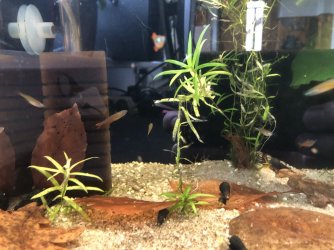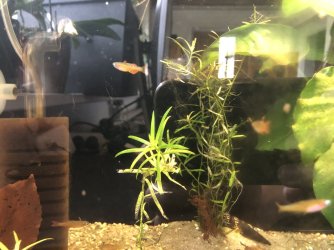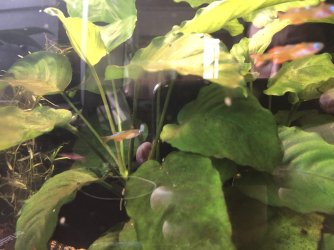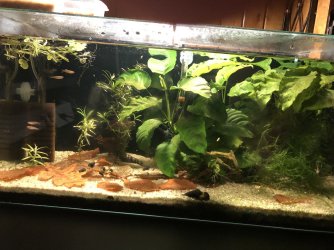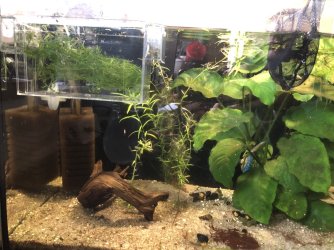Beastije
Fish Addict
I recently (sunday) got a batch of 10 pseudomugil luminatus. I am not sure how old they are, but based on the full coloring, they are not juveniles. I have a 5m/5f ratio and it took the males like 3 hours in the new tank to start sparring/fin showing.
I absolutely adore their ear fins, too bad I cant take a decent picture yet, they are just too fast.
Since I have only had them two days, I assume most of their behavior is stress related. They hang out near the bottom and in one corner, more in the open area than the planted one. I expected them to be more upper level/surface level, but that is ok.
I purchased a piece of wood I am currently soaking to put on the left side of the tank to help them feel more at ease. I will also try to include more plants, but cant overdoit that much, low light/low fert. I am hoping for the pennywort on the surface to start growing and producing roots and act like a surface plant.
Given there is not that much info on them, what are your recommendations? They are slow to notice food but then they are good at eating anything I have given them (live bbs, live microworms, frozen bbs, frozen cyclops, will try some dried next)
I also read how you basically cant have any offspring in the tank with adult, so I plan to wait some time and take out the moss I have in there and place it in a breeder box in the same tank with them with hope of getting some eggs to develop.
How long should I be waiting for the eggs to be deposited, like a month for them to settle down? They already spend a lot of the time in the moss, but mostly to eat stuff I guess will be hard to pick a correct time when the eggs are still there too.
will be hard to pick a correct time when the eggs are still there too.
I watched some youtube breeding videos so will hopefully recognize the eggs in the moss.
Thank you
I absolutely adore their ear fins, too bad I cant take a decent picture yet, they are just too fast.
Since I have only had them two days, I assume most of their behavior is stress related. They hang out near the bottom and in one corner, more in the open area than the planted one. I expected them to be more upper level/surface level, but that is ok.
I purchased a piece of wood I am currently soaking to put on the left side of the tank to help them feel more at ease. I will also try to include more plants, but cant overdoit that much, low light/low fert. I am hoping for the pennywort on the surface to start growing and producing roots and act like a surface plant.
Given there is not that much info on them, what are your recommendations? They are slow to notice food but then they are good at eating anything I have given them (live bbs, live microworms, frozen bbs, frozen cyclops, will try some dried next)
I also read how you basically cant have any offspring in the tank with adult, so I plan to wait some time and take out the moss I have in there and place it in a breeder box in the same tank with them with hope of getting some eggs to develop.
How long should I be waiting for the eggs to be deposited, like a month for them to settle down? They already spend a lot of the time in the moss, but mostly to eat stuff I guess
I watched some youtube breeding videos so will hopefully recognize the eggs in the moss.
Thank you


